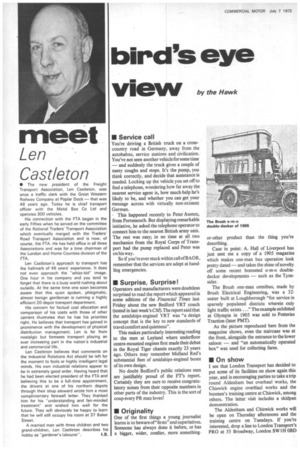birds eye
Page 42

If you've noticed an error in this article please click here to report it so we can fix it.
view by the Hawk • Service call
You're driving a British truck on a crosscountry road in Germany, away from the autobahns, service stations and civilization. You've not seen another vehicle for some time — and suddenly the truck gives a couple of nasty coughs and stops. It's the pump, you think correctly, and decide that assistance is needed. Locking up the vehicle you set off to find a telephone, wondering how far away the nearest service agent is, how much help he's likely to be, and whether you can get your message across with virtually non-existent German.
This happened recently to Peter Austen, from Portsmouth. But displaying remarkable initiative, he asked the telephone operator to connect him to the nearest British army unit. The rest was easy; in no time at all two mechanics from the Royal Corps of Transport had the pump replaced and Peter was on his way.
So if you're ever stuck within call of BAOR, remember that the services are adept at handling emergencies.
• Surprise, Surprise!
Operators and manufacturers were doubtless surprised to read the report which appeared in some editions of the Financial Times last Friday about the new Bedford YRT coach (tested in last week's CM). The report said that the amidships-engined YRT was "a design concept that is the key to new standards of travel comfort and quietness".
This makes particularly interesting reading to the men at Leyland where underfloor centre-mounted engines first made their debut in the Royal Tiger chassis exactly 23 years ago. Others may remember Midland Red's substantial fleet of amidships-engined buses of its own design.
No doubt Bedford's public relations men are justifiably proud of the FT's report. Certainly they are sure to receive congratulatory noises from their opposite numbers in other parts of the industry. This is the sort of coup every PR man loves!
• Originality
One of the first things a young journalist learns is to beware of" firsts" and superlatives. Someone has always done it before, or has a bigger, wider, costlier, more something or-other product than the thing you're describing.
Case in point: A. Hall of Liverpool has just sent me a copy of a 1905 magazine which makes one-man bus operation look pretty dated — and takes the shine of novelty off some recent bonneted o-m-o doubledecker developments — such as the Tynesider.
The Brush one-man omnibus, made by Brush Electrical Engineering, was a 32seater built at Loughborough "for service in sparsely populated districts wherein only light traffic exists ..." The example exhibited at Olympia in 1905 was sold to Potteries Traction (later PMT).
As the picture reproduced here from the magazine shows, even the staircase was at the front, alongside the entrance to the lower saloon — and "an automatically operated box" was used for collecting fares.
• On show
I see that London Transport has decided to put some of its facilities on show again this year, and is encouraging parties to take a trip round Aldenbam bus overhaul works, the Chiswick engine overitaul works and the busmen's training centre at Chiswick, among others. The latter visit includes a skidpan demonstration.
The Aldenham and Chiswick works will be open on Thursday afternoons and the training centre on Tuesdays. If you're interested, drop a line to London Transport's PRO at 55 Broadway, London SW1H OBD
















































































































































